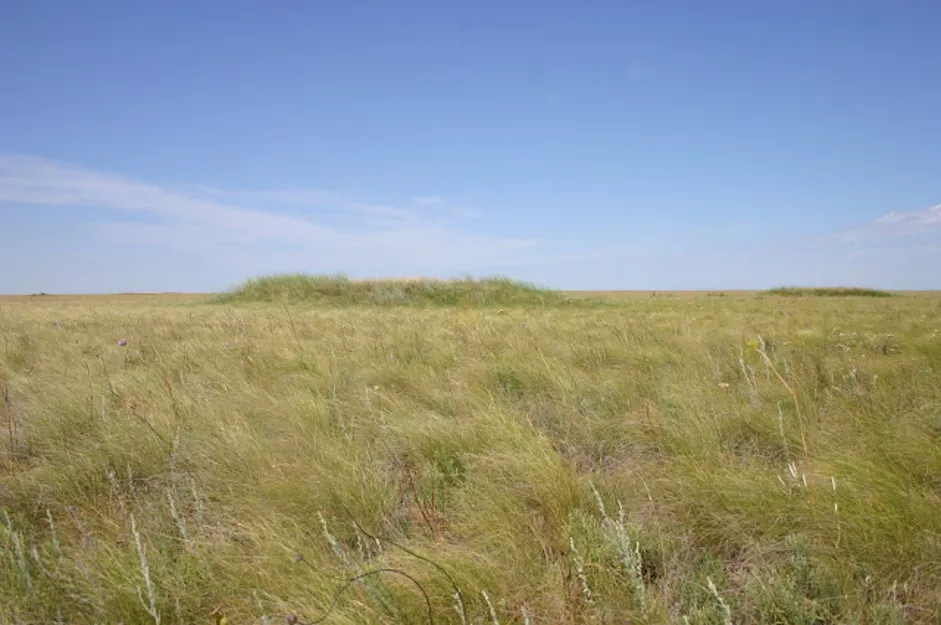The Journal of Arid Environments has published an article by researchers from the ELKH Centre for Ecological Research on the curious habits and impact on vegetation of the steppe marmot (Marmota bobak).
The unusual rodent, also known as the bobak marmot, is the largest animal of the marmota genus. This subspecies of the Eurasian variety inhabits the steppe zones of the Ukraine, Russia and Kazakhstan. These steppe rodents live in colonies and build mounded burrows much like many of their relatives near and far. Underneath the mound is a complex tunnel system which can be several meters deep and offers protection from cold, heat and predators. These mounded burrows are usually 0.5-0.8 meters high, and several square meters in diameter. These characteristic mounds of the steppe landscape have long fascinated explorers and artists alike.
In this study, the researchers from the Lendület Seed Ecology Research Group were curious to discover whether there was a difference between vegetation found on mounded burrows versus the surrounding steppes. The study took place in the Naurzum Reserve in Northern Kazakhstan, on steppes dominated by the Stipa lessingiana species of feathergrass. The study found that the vegetation of mounded burrows was significantly different from steppe vegetation. Soil moisture content on mounded burrows is less than on intact steppe and flat burrows, so these mounded burrows were the driest habitats in the region. Aridity, regular trampling and fertilizing with feces contributed to the characteristic increased cover of drought-tolerant steppe grasses, including crested wheat grass (Agropyron cristatum), which is also native to Hungary, as well as several ruderal species. It is interesting to note that, based on a study of marmot feeding habits (Ronkin et al., 2009), the plants growing on these burrows also happen to be among their favorites.
The marmots spend a majority of their time on or in the burrow, and mostly forage nearby to make hiding from eagles quicker and easier. The published results indicate that the rodents' trampling, grazing and fertilizing with feces are the very habits that provide favorable conditions for their preferred vegetation, and this, as an interesting analogy, is in fact 'gardening' - pruning, fertilizing and preparing the soil. Because of the constant trampling, fertilizing and grazing, marmot gardens sprout earlier and start drying out later than the surrounding steppe vegetation. This is very important during the summer dry season, when they need to start fattening up for hibernation. Marmot gardens help maintain their preferred foraging plant populations on a spatial and temporal scale because mounded burrows create stepping stones that can sustain the meta-population structure of these plants, which is beneficial for the whole marmot colony.
Steppe marmots are important ecosystem engineers on the Eurasian steppe. Their mounded burrows are separate little habitat islands, the characteristic vegetation of which they themselves cultivate and sustain. Based on the most recent studies (Koshkina et al. 2019) there are currently only around 1.2 million actively used marmot burrows in Kazakhstan. (These are partially found near arable land and not on the steppe as changes to land use in recent decades has also significantly affected marmot populations. However, there are still several hundred thousand steppe burrows). The range of the species in the past was larger, and therefore the number of active and abandoned burrows was, presumably, substantially larger. It's conceivable that these habitat islands acted as stepping stones for the dispersal of plant species in the past. But of course, proving this would require further research.
Article reference:
Valkó, O.; Tölgyesi, C.; Kelemen, A.; Bátori, Z.; Gallé, R.; Rádai, Z.; Bragina, T. M.; Bragin, Y.; Deák, B. (2020): Steppe Marmot (Marmota bobak) as ecosystem engineer in arid steppes. Journal of Arid Environments doi: 10.1016/j.jaridenv.2020.104244
The full article can be accessed on the journal's website by clicking here.
